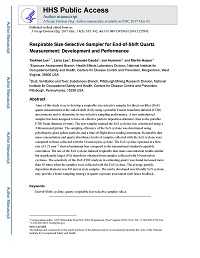Mining Publication: Respirable Size-Selective Sampler for End-of-Shift Quartz Measurement: Development and Performance
Original creation date: May 2017
Aims of this study were to develop a respirable size-selective sampler for direct-on-filter (DoF) quartz measurement at the end-of-shift (EoS) using a portable Fourier transform infrared (FTIR) spectrometer and to determine its size-selective sampling performance. A new miniaturized sampler has been designed to have an effective particle deposition diameter close to the portable FTIR beam diameter (6-mm). The new sampler (named the EoS cyclone) was constructed using a 3 dimensional printer. The sampling efficiency of the EoS cyclone was determined using polydisperse glass sphere particles and a time-of-flight direct reading instrument. Respirable dust mass concentration and quartz absorbance levels of samples collected with the EoS cyclone were compared to those collected with the 10-mm nylon cyclone. The EoS cyclone operated at a flow rate of 1.2 1 min-1 showed minimum bias compared to the international standard respirable convention. The use of the EoS cyclone induced respirable dust mass concentration results similar but significantly larger (5%) than those obtained from samples collected with 10-mm nylon cyclones. The sensitivity of the DoF-FTIR analysis in estimating quartz was found increased more than 10 times when the samples were collected with the EoS cyclone. The average particle deposition diameter was 8.8 mm in sixty samples. The newly developed user friendly EoS cyclone may provide a better sampling strategy in quartz exposure assessment with faster feedback.
Authors: T Lee, L Lee, E Cauda, JA Hummer, M Harper
Peer Reviewed Journal Article - May 2017
NIOSHTIC2 Number: 20048860
J Occup Environ Hyg 2017 May; 14(5):335-342
See Also
- Analysis of the Silica Percent in Airborne Respirable Mine Dust Samples from U.S. Operations
- Control of Respirable Dust
- Direct-on-Filter alpha-Quartz Estimation in Respirable Coal Mine Dust using Transmission Fourier Transform Infrared Spectrometry and Partial Least Squares Regression
- The Effects of Low Quartz Mass Loading and Spatial Variability on the Quartz Analysis of Surface Coal Mine Dust Samples
- Evaluating Portable Infrared Spectrometers for Measuring the Silica Content of Coal Dust
- Improving Silica Dust Control Through Targeted Research
- Improving the Performance of Fan-Powered Dust Collectors in Stone-Cutting Applications
- Laboratory Evaluation of a Canopy Air Curtain for Controlling Occupational Exposures of Roof Bolters
- Reducing Enclosed Cab Drill Operator's Respirable Dust Exposure at Surface Coal Operation With a Retrofitted Filtration and Pressurization System
- Research Toward Direct Analysis of Quartz Dust on Filters Using FTIR Spectroscopy
- Content source: National Institute for Occupational Safety and Health, Mining Program


 ShareCompartir
ShareCompartir
